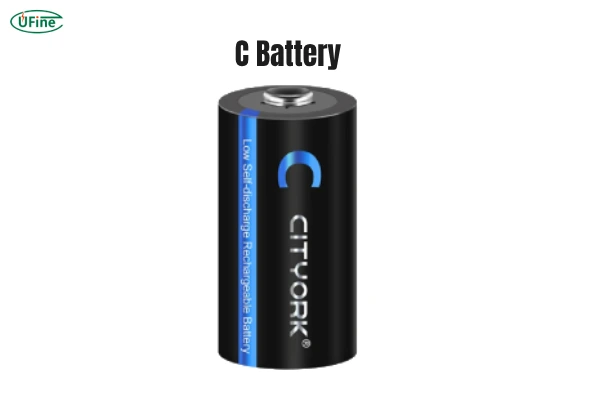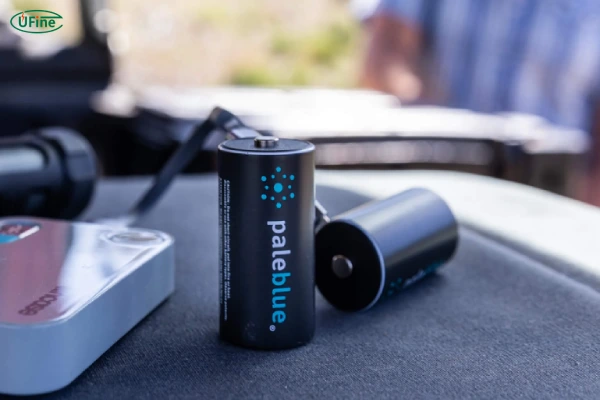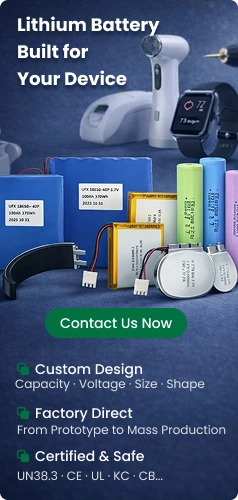
C batteries are the go-to power source for many devices that need more than just a small burst of energy. Whether it’s your child’s toy that needs to run for hours or a flashlight that must be ready in emergencies, C batteries are designed for situations that demand steady, reliable power. However, not all C batteries are the same, and their performance can vary significantly depending on their type, capacity, and intended use. In this comprehensive guide, we will explore every detail you need to know about C batteries, helping you make better decisions the next time you find yourself shopping for these energy sources.
Part 1. Understanding C battery
C batteries, sometimes referred to as R14 or LR14, are cylindrical batteries with a moderate size, placed between the larger D batteries and the smaller AA or AAA ones. They are most commonly used in medium-drain devices that need a consistent power supply over time. One of the key reasons they are favored in certain applications is their size, which allows for higher energy storage compared to smaller batteries, yet they remain compact enough to be easily portable.
The name “C battery” doesn’t refer to a specific chemistry but rather the battery’s size and general specifications. A C battery can be made with several different chemistries, including alkaline, zinc-carbon, lithium, and nickel-metal hydride (NiMH). Each of these chemistries offers unique performance characteristics, which is why it’s essential to choose the right type for your particular device.
Part 2. Voltage and capacity
Voltage and capacity are two critical factors that determine how well a battery performs and how long it will last. Standard C batteries deliver a voltage of 1.5V in the case of alkaline or zinc-carbon variants. Rechargeable C batteries, like NiMH, provide a slightly lower voltage, around 1.2V.
When it comes to capacity, which is measured in milliamp-hours (mAh), C batteries vary significantly depending on their chemistry. Alkaline C batteries typically offer between 6,000 to 8,000 mAh, making them ideal for high-drain devices such as large flashlights or portable radios. In contrast, NiMH rechargeable batteries offer between 2,500 to 6,000 mAh. This makes them suitable for devices that are used frequently, such as toys or audio equipment, and where the ability to recharge them repeatedly outweighs their slightly lower initial capacity.
Part 3. Weight
The weight of a battery can affect both its portability and how it interacts with the device it’s powering. C batteries are heavier than their smaller counterparts like AA or AAA due to their larger size and higher capacity. Alkaline C batteries generally weigh around 65 grams, whereas rechargeable NiMH C batteries weigh slightly more, typically between 70 to 75 grams. The heavier weight is important for balance in devices like flashlights, where the distribution of weight can affect how the device feels in your hand.
In practical terms, while the weight of a C battery might not be a significant factor for stationary devices, it becomes noticeable in portable applications. Devices such as hand-held radios, lanterns, or larger toys rely on the heavier C battery to provide the necessary power without making the device feel unwieldy.
Part 4. Size and shape
C batteries have a standardized size, making them easily recognizable and compatible with many different devices. They are 50 millimeters in length and about 26 millimeters in diameter, with a cylindrical shape that fits snugly into most battery compartments designed for medium-sized power sources.
The compact but powerful design of C batteries allows them to hold more energy than smaller sizes like AA or AAA, without being too large to be practical. This makes them an optimal choice for medium-drain devices, where battery life and compact design are equally important.
All About AA Rechargeable Batteries
AAA Rechargeable Batteries: Your Essential Guide
Part 5. Types
The chemistry of a battery plays a crucial role in determining its performance, lifespan, and even environmental impact. The most common types of C batteries are:
- Alkaline C Batteries: Known for their long shelf life and reliability in moderate to high-drain devices. Alkaline batteries are non-rechargeable and are best suited for devices that don’t require frequent battery changes, such as flashlights, radios, and some toys.
- Zinc-Carbon C Batteries: A more affordable option, zinc-carbon C batteries are ideal for low-drain devices. However, they do not last as long as alkaline batteries and are not ideal for high-drain applications.
- Nickel-Metal Hydride (NiMH) Rechargeable C Batteries: NiMH batteries are environmentally friendly and can be recharged hundreds of times. They are ideal for devices that are used frequently, such as toys and audio equipment. Their slightly lower voltage (1.2V) compared to alkaline batteries is often balanced by the convenience of rechargeability.
- Lithium C Batteries: Although less common, lithium C batteries are used in specialized devices that require a long-lasting power source. They are typically more expensive but provide excellent energy density and shelf life.
Part 6. Pros and Cons
Pros:
- Long-lasting power: C batteries provide higher capacity compared to smaller batteries, making them ideal for medium-drain devices.
- Variety of chemistries: Available in rechargeable and non-rechargeable formats, offering flexibility depending on your device’s power needs.
- Wide availability: C batteries can be found in most stores, making them a convenient choice for replacements.
Cons:
- Heavier weight: Compared to smaller batteries, C batteries can be bulky, which might be a drawback for certain portable devices.
- Higher cost: Rechargeable C batteries, in particular, tend to be more expensive upfront compared to smaller sizes.
Part 7. Application
C batteries are versatile and are used in many different types of devices, especially those that need reliable power over extended periods. Some common applications include:
- Toys: Many children’s toys, especially those with motors or lights, require C batteries due to their higher energy capacity.
- Flashlights: Larger flashlights, particularly those used in emergency situations, depend on the longer-lasting power of C batteries.
- Portable Radios: Battery-powered radios, especially models designed for outdoor use, often require C batteries to ensure long hours of operation.
- Medical Equipment: Some portable medical devices also rely on C batteries, where dependable, consistent power is critical.
Part 8. Is C battery rechargeable?
Yes, C batteries are available in rechargeable formats, specifically NiMH chemistry. These rechargeable C batteries are ideal for devices that are used frequently, as they can be recharged hundreds of times, saving money and reducing waste. While they have a lower initial voltage compared to non-rechargeable batteries, their long-term benefits outweigh this minor downside for many users.
Part 9. How long does a C battery last?
The lifespan of a C battery depends on several factors, including the device it’s powering, the battery’s chemistry, and how often the device is used. Alkaline C batteries, for example, can last up to 10 years in storage and provide about 10 hours of continuous use in a medium-drain device like a flashlight. Rechargeable NiMH C batteries, while offering a shorter use time of around 6-8 hours per charge, can be recharged hundreds of times, making them more economical in the long run.
Part 10. Are C Batteries the same as AA and AAA?
Although C, AA, and AAA batteries all share the same cylindrical shape, they are vastly different in terms of size, capacity, and use. C batteries are larger, providing significantly more power than AA or AAA batteries, making them suitable for devices that require more energy. AA and AAA batteries are used in smaller, low-drain devices such as remote controls and clocks, whereas C batteries are often found in higher-drain devices like flashlights, toys, and radios. They are not interchangeable without an adapter due to their size difference.
By understanding the different types, capacities, and applications of C batteries, you can make an informed choice that meets your power needs. Whether for home use or on-the-go devices, C batteries offer the perfect balance of size, power, and longevity.
Related Tags:
More Articles

Battery Load Test: A Comprehensive Guide
Step-by-step battery load test guide for car, solar & industrial use. Learn how to load test a battery, interpret voltage charts, and avoid common mistakes.
The Comprehensive Guide to Battery Balancing and Battery Balancer
Discover how battery balancers improve lithium battery performance, lifespan, and safety. Learn types, functions, and tips to choose the right balancer.
What Is the Best Voltage for a Chainsaw Battery?
Compare 12V-80V chainsaw batteries for light pruning, medium firewood, and professional cutting. See best battery chainsaw with runtime charts and safety tips.
Lithium VS. Alkaline Batteries: A Comprehensive Comparison
Lithium batteries last 3–7× longer than alkaline and perform better in cold weather. Compare lifespan, cost, safety, and best uses to choose the right battery.
Comparing Lithium-Sulfur and Lithium-Ion Batteries: Which is Right for You?
Compare lithium-sulfur (Li-S) and lithium-ion batteries on energy, lifespan, cost, safety, and applications. Best choice for drones, EVs, and electronics.



